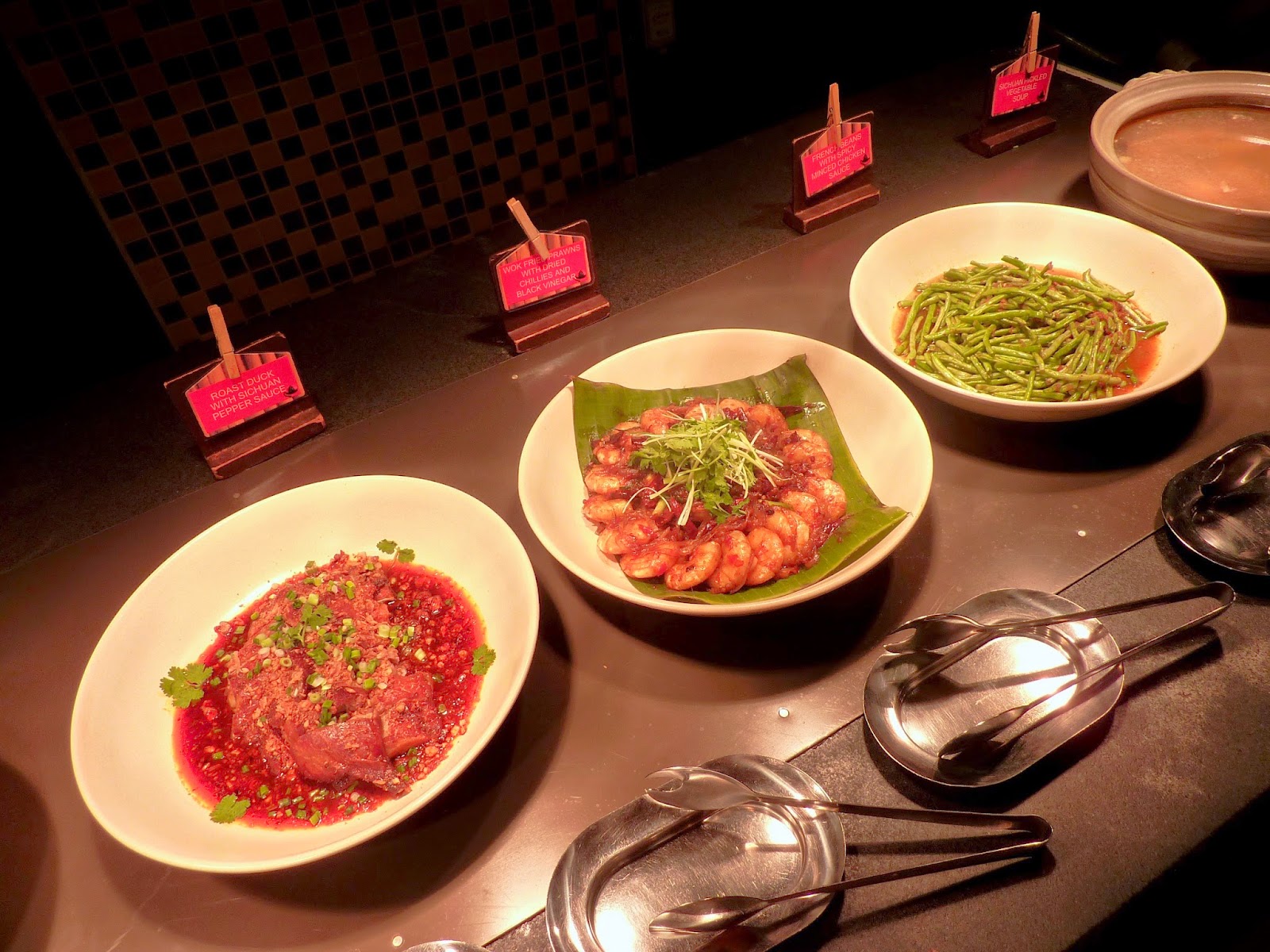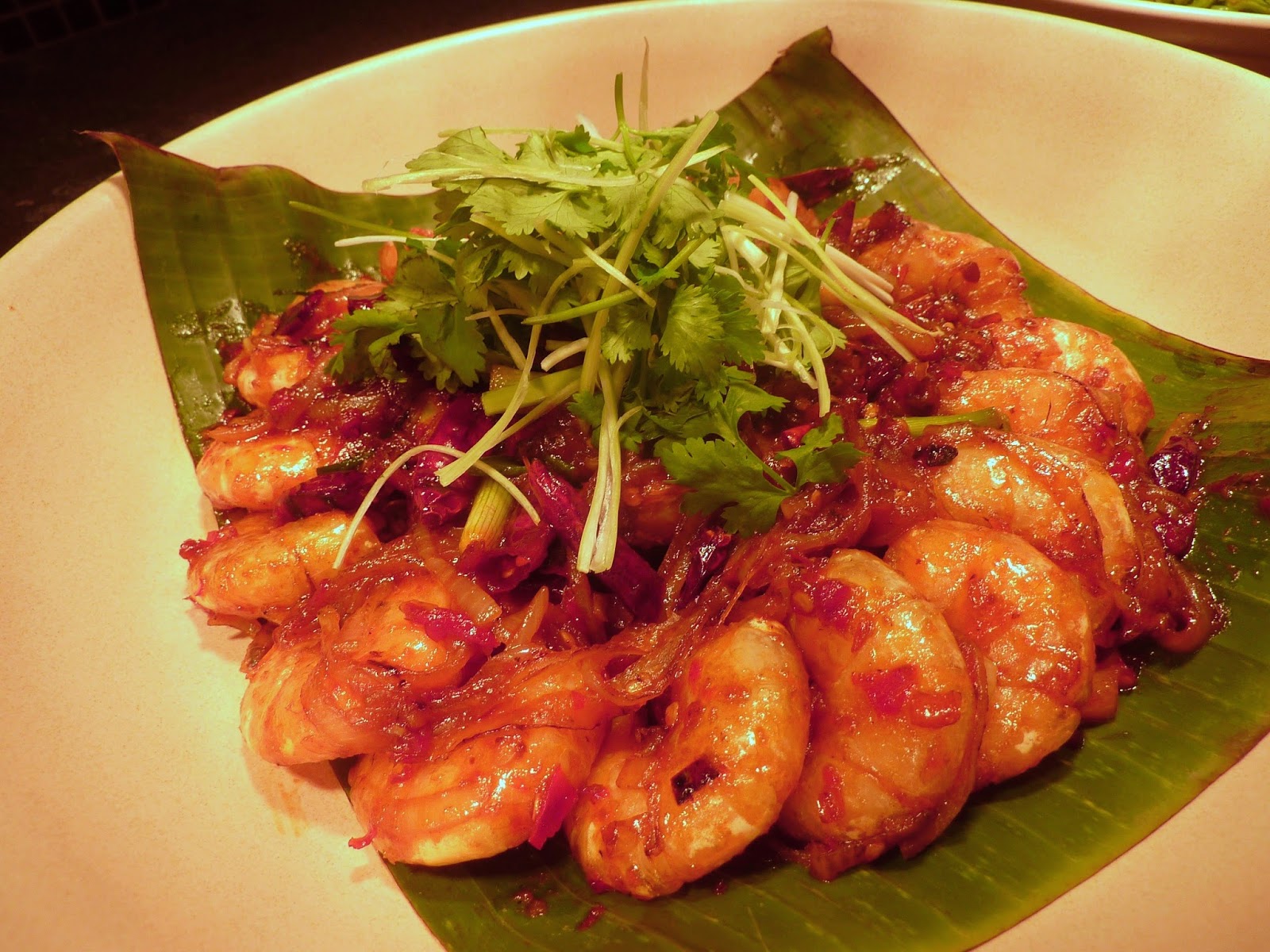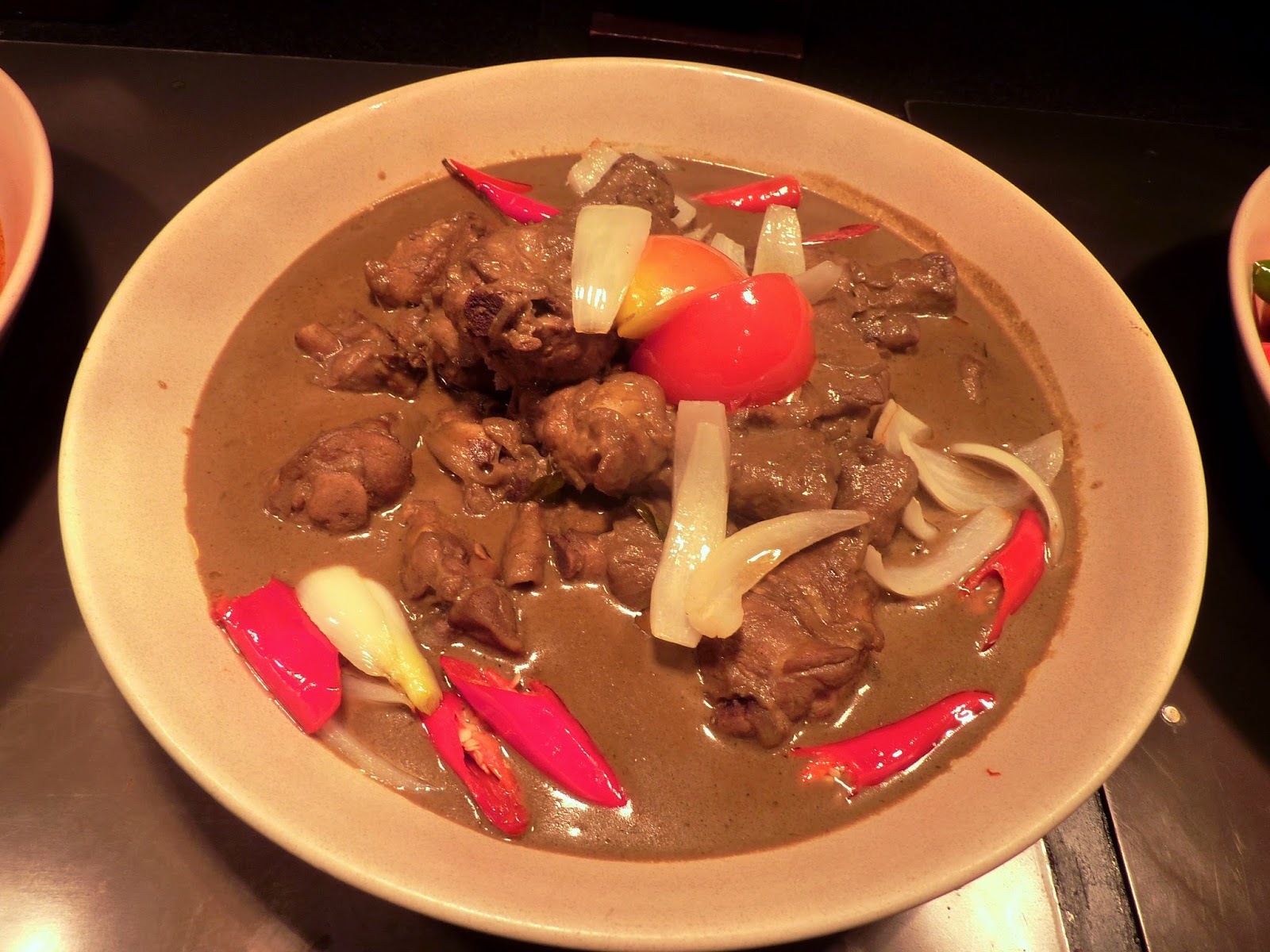Rasa Sayang Resort & Spa at Batu Ferringhi is the destination of my next food review. This is my second invited review to Spice Market Café since the previous one in March.
The International Buffet Dinner at Spice Market is still on-going throughout the year until a week before Christmas. Normal price is RM128.00++ for adults and RM64.00++ for children.
Like before, the "P60" deal applies on Mondays and Tuesdays. This confers 40% discount on the normal adult price. By popular demand, this offer is now extended to Wednesdays and Thursdays, where adult patrons enjoy 30% and 20% discount respectively.
One of the main objectives of this food review is to catch Chef Shantanu Seth who takes the helm of Rasa Ria's Indian restaurant, Naan - Flavours Of India. Starting his career in 1999, Chef Shantanu joined Shangri-La in May 2012 as the Chef de Cuisine of Naan.
In pursuit of culinary diversity, Chef Shantanu has worked with many restaurants across several continents, including places like India, Tanzania and Paris. As Chef Shantanu puts it, culinary art is a life-long journey of exploration. Ever bold to venture into uncharted waters, new recipes are constantly being explored while existing ones are enhanced.
"Cooking is a passion and we do it with heart for the best result. Without passion, no spices in the world can enhance the taste of food." - Chef Shantanu Seth
Sporting a friendly and down-to-earth personality, Chef Shantanu pointed out several exciting challenges as a guest chef at Spice Market. In contrast to table-service restaurants, buffet setting requires a different approach in designing the menu. For instance, intensity of spices have to be adjusted to cater for a larger crowd, not just an elite few.
Chef Shantanu serves as Spice Market's guest chef from 25 May 2014 to 29 May 2014. Nevertheless, his signature dishes are available through 26 June 2014. Not all signature dishes are available every day; the menu is rotated on daily basis.
As a large subcontinent, Indian cuisine enjoys a large diversity in cooking techniques and philosophies. North Indian cuisine is renowned for its grilled meat and naan bread using a tandoor oven. On the other hand, South Indian dishes are generally curry-based, relying on regional spices and coconut milk to enhance flavor of meat and vegetables. With the advent of fusion cuisine, the lines in between have blurred somewhat.
The first masterpiece of Chef Shantanu is the Laal Maans (लाल मांस), literally meaning "red mutton" in Hindi. This curd-infused mutton curry is a deliacy in Rajasthan, an arid Indian state to the northwest. The use of powerful spices was originally intended to mask the strong odor of wild game like deer. Typically spice mixture used with this dish is scorching hot by Malaysian standards, therefore pungency has been toned down to adapt to local taste buds.
Another exquisite delicacy crafted by Chef Shantanu is the Malabar Prawn Curry (मालाबार झींगा करी). Hailing from the maritime region of Malabar, this dish has a creamy curry enhanced by savoriness of fresh prawns.
Our feast is further delighted with a treat to the Murg Malai Tikka (मुर्ग़ मलाई टिक्का). Deboned chicken chucks are marinated with cheese, cashew nuts and cheese, then roasted in a tandoor oven to perfection. The result is a chicken dish rich in diverse flavors.
The Tandoori Lamb (तंदूरी मेमने) is also lovely as it is perfectly flavored. I would have taken a second helping if this were not a full-fledged buffet setting.
As for the Tandoori Fish (तंदूरी मछली), I find the flesh being too dry to be enjoyed comfortably. I can't complain because intense heat from the oven easily robs moisture from delicate fish fillets. Perhaps there is a way to rejuvenate the fish after roasting, perhaps with lime?
The Chicken Satay is reasonable in terms of taste. As usual, satay is usually served alongside fresh onions, chopped cucumber and ketupat (rice cakes).
Tamatar Ka Kut (టమోటా కా కుట్) is a signature dish in Hyderabad, a metropolis in central India. The key ingredient in this curry are fresh tomatoes flavored with mustard and tamarind, yielding a hint of sour aftertaste.
Sambhar (சாம்பார்) is a lentil-based vegetable stew made popular in southern India. This vegetarian crowd favorite uses various vegetables such as tomatoes and onions, boiled with tamarind pulp and sambar powder until half-cooked. Lentils are then added until the vegetables are done.
The name of the dish Aloo Gobi Matar (आलू गोभी मटर) literally spells the three key ingredients out: potatoes, cauliflower and peas. The vegetables are stir-fried with tomatoes and onions, making them fiery and aromatic upon serving.
Lemon Rice (नींबू चावल) is made from basmati long-grained rice cooked with peanuts, curry leaves, mustard and lime. The rice is light and airy, sufficiently delectable to be enjoyed on its own right.
The Indian dishes so far are gratifying to say the least, but we are just one-sixth through dinner tonight. The Western station is our next destination, this time the theme is Italian.
Spinach And Ricotta Cannelloni is the main highlight today. This is a dish made with cylindrical pasta baked with tomato sauce, spinach and ricotta (whey cheese) as stuffings, making this a cheesy treat reminiscent of lasagna.
Vegetable Quesadillas are bite-sized finger food usually associated with Mexican cuisne, so it begs the question what it is doing under an Italian banner. Nevertheless, the savory fillings sandwiched within flour tortilla are enjoyable in small amounts.
The Cajun Scented Fish Fillet takes a spotlight on its own (literally). A slab of fish fillet is slowly grilled to the right degree, then cut into smaller portions only upon request. Truthful to Cajun culinary arts, the fish is served with citrus cream sauce which enhances enjoyment of fish to an entirely new level.
Next up, we have an interesting serving of Braised Beef Stew With Olive And Artichoke, elegantly garnished with black olives and onion rings.
As for the Chicken Milanese On Tomato Coulis, I love how the chicken is nicely flavored with tomato purée.
The next dish is Grilled Fish Fillet With Salsa. The fish fillet are grilled with onions and cherry tomatoes.
Common in Mediterranean cuisine, the Prawn Provencale demonstrates how fresh shrimps can also be properly prepared in a tomato-based sauce.
Also available is a dish of Roasted Herb Potatoes.
Moving from the West to the East, the Chinese station features Sichuanese cuisine this week. As opposed to Chinese cuisine in general, Sichuanese recipes deploy pungent and spicy ingredients such as Sichuan pepper, chili peppers and garlic.
By far, the most appealing dish at the Chinese station is the Roast Duck With Sichuan Pepper Sauce. The first plate was depleted within an hour. Fortunately, it was duly replenished so that more diners may enjoy. The tender roast duck is served with fiery chili oil, giving an exquisite flavor beyond my wildest imagination.
Also impressive but overshadowed by its popular neighbor, the Wok Fried Prawns With Dried Chillies And Black Vinegar should not be overlooked. The vinegar-based sauce definitely works well to enhance flavor of shrimps.
As for something vegetarian, the French Beans With Spicy Minced Chicken Sauce may also be too spicy for the less-adventurous diner.
Moving to the adjacent Malay counter, the Mussel Masak Lemak uses yellow curry made from coconut milk.
Fish Masak Merah is a red curry of fish fillet, tomatoes and peapods.
The Chicken Kurma is not as spicy yet savory nevertheless.
There is also a serving of Vegetable Dhalca made from potatoes, cauliflower, long beans, tomatoes, onions and chili peppers.
Taking a detour to the Japanese counter, several types of pre-made sushi (寿司) are available. One may also request for sashimi (刺身) to be freshly sliced upon ordering. Examples of fish available for sashimi are salmon, tuna, butterfish etc. Overall, the ingredients are well-stocked; it is obvious that Rasa Sayang spares no expense when it comes to quality and freshness.
As for sushi, these are mostly maki (巻き) and nigiri (握り) types, although I suspect that the chef can cater to special orders such as temaki (手巻き).
One of my favorite type of sushi is inari (稲荷) or sweetened bean curd.
One may sample some Potato Sarada (ポテトサラダ), a transliteration of potato salad in Japanese. The salad contains potato cubes, carrots, peas and corn held together in thick, starchy gravy.
Japanese culinary enthusiasts may also fancy the fine selection of pickled dishes (漬物) such as Chuka Idako (中華イイダコ) or seasoned baby octopus, Chuka Kurage (中華クラゲ) or seasoned jellyfish, Shiba Zuke (柴漬け) or pickled eggplant, Chuka Wakame (中華ワカメ) or seasoned seaweed, and Kimchee (キムチ).
Condiments available for sushi and sashimi are Wasabi (山葵) and Pickled Ginger (ガリ).
A stroll down the cold-served seafood aisle reveals several interesting delicacies. My personal favorite are scallops.
Mussels are also nice especially with lemon juice.
The clams are fresh too, although the sizes are quite small for true enjoyment.
The key to enjoying cold-served seafood are the dipping sauces. There are a handful of sauces available, but my recommendation is the Chili Spice Aioli. This is a mildly-spicy dressing made from egg yolks, olive oil, mustard and garlic.
Patrons who enjoy Malaysian street food can be treated with various types of noodles with soup. The large array of ingredients reveals over a dozen types of noodles, meatballs, fish balls, crabsticks, fish cakes, shrimps, mushrooms and fresh vegetables.
As for diners who are bold enough to venture into Penang street food territory, the Nyonya Assam Laksa is the right bet. As expected, the fish gravy is rich and plentiful indeed.
In the cold cuts section, there are several large platters of Smoked Fish, Roasted Lamb, Chicken Terrine.
Although I am not a notable fan of dairy products, curiosity got the better of me when I moved to the cheese section. I helped myself with a small sample of each type of gourmet cheese.
Exquisite cheese choices are cheddar, emmental, gouda, camembert and brie cheeses.
Cheese is not popular in Malaysia as it is in Western countries, therefore it serves a small niche market here.
Cheese is often enjoyed with preserved fruits and nuts like pecans, apricots, almonds and raisins.
In the bakery section, a decent selection of gourmet bread is available to complement the cheese.
The salad bar features various pre-mixed salad such as Salmon Nicoise.
Individual salad ingredients are also available for the more health-conscious. A handful of salad dressings are available for enjoyment.
Last but not least, I helped myself at the desserts station. The featured dessert today is Crème Brûlée, a French custard with a layer of caramel on top. Three flavors are available: raspberry, chocolate and coconut.
Upon order, some sugar is sprinkled on top the cup of crème brûlée. The sugar is then caramelized masterfully using a small torch. This forms a hard layer of caramel immediately above the soft custard.
The coconut crème brûlée looks appealing visually, but my tongue is more gratified by this dessert. The custard itself is lovely and well-mixed with yolk, thickener and coconut flavoring.
The chocolate crème brûlée is quite good too. The rich dark chocolate flavor gives a pleasantly bitter taste underneath the thin layer of sweet caramel.
Spice Market is also renown for its fine selection of specialty cakes, pies and tarts. Today's choices are Chocolate Walnut Cheesecake, Sour Cherry Pie and French Apple Tart.
As though that is not enough, there are also Chocolate Fudge, Pandan Kaya Cake and Apple Pie Crumble available for indulgence.
Guests who never grow tired of chocolate will be delighted by the mere sight of a chocolate fountain. The chocolate is kept flowing continuously because it hardens quickly when left still. This chocolate property allows it to form a coating on the surface of dips.
Dips available are dried figs, marshmallows and dried apricots. Unlike the cakes, the choices are essentially unchanged since my precious visit. I think Spice Market can consider rotating different types of dips such as cheese, strawberries and bananas. Who knows, guests may find a new dip more appealing?
Crêpes are available and only made to order. There are just too many ingredients to choose from: cranberries, raisins, peaches, walnuts, apricots etc. Be creative or simply ask the chef to surprise you!
Ice Kacang and Cendol are also available. These are Malaysian favorite desserts made from sweetened shaved ice. Once again, the array of syrups and ingredients are simply overwhelming. Popular ones are attap chee (亚答子) or nipa palm fruit, nutmegs, creamed corn, red beans, jelly noodles, and grass jelly.
Bubur Gandum or wheat porridge is a local cereal-based dessert. At this point of time, most diners are probably surfeited, so go easy with this dessert.
Fresh fruits on the platter are honeydew, pineapples, papaya, watermelon and jackfruit. The choices are not particularly plentiful, but the appearance of jackfruit is quite welcoming.
A kids section is also available at Spice Market. This section provides children's favorite foods at no extra charge.
Drinks (apart from water) are not included in the price of the buffet. Fresh fruit juices are grapefruit, watermelon, oranges and apples just to name a few.
Name: Spice Market Café
Address: Rasa Sayang Resort & Spa, Jalan Batu Ferringhi, 11100 Batu Ferringhi, Pulau Pinang
Contact: 04-888-8888
Business hours: 6:30pm-10:30pm
Website: Click here
Coordinates: 5.47965 N, 100.25481 E
Directions: From Tanjung Bungah, travel west towards Batu Ferringhi. Rasa Sayang Resort & Spa is approximately 4.2 kilometers from Tanjung Bungah's floating mosque, located on the right. Spice Market Café is at Lobby level of the Garden wing.







































































No comments:
Post a Comment